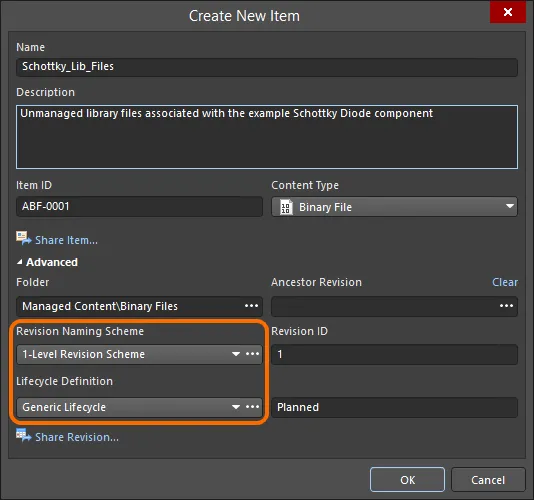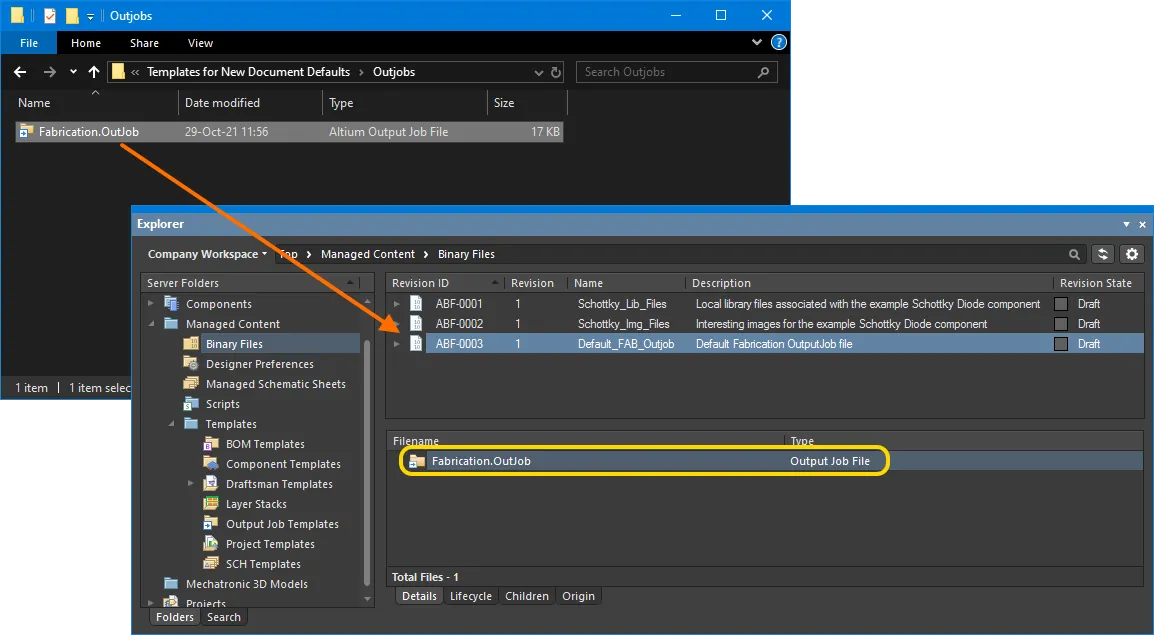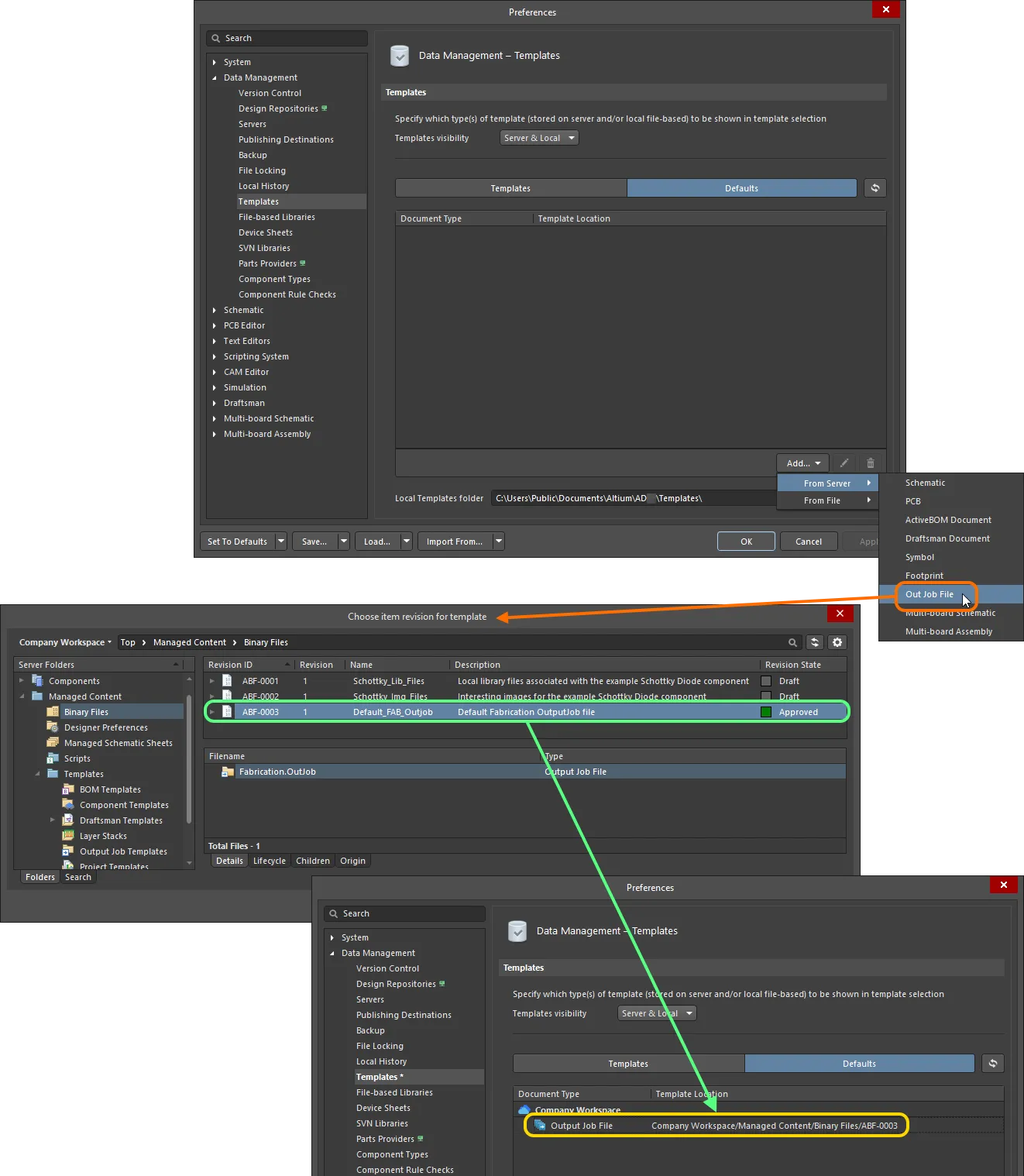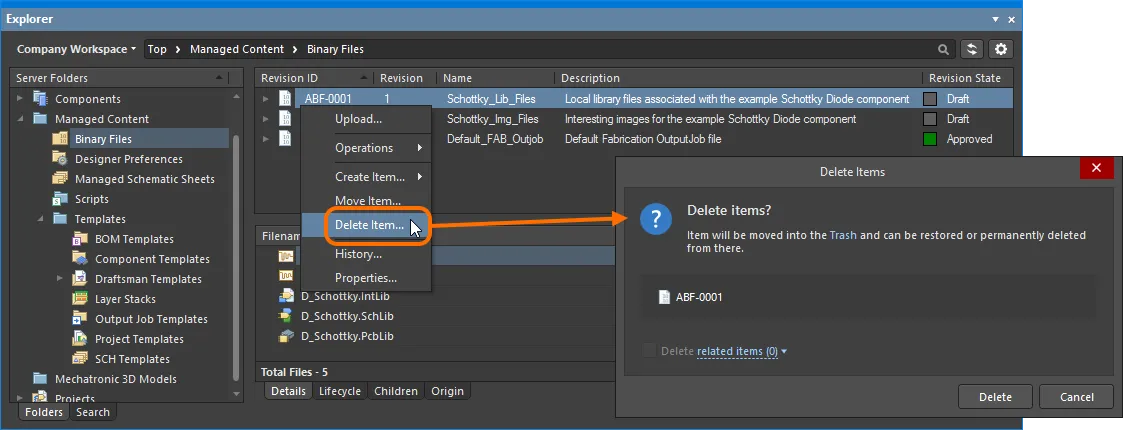Parent page: Workspace Content Types
Altium Designer, in conjunction with your conencted Workspace, caters for the ability to store free files in a special content type – the Binary File Item. Such Items can be created to accommodate one or more files of any format. This allows you to effectively take advantage of the Workspace's secure nature, and underlines the Workspace as being the perfect place to store anything, including your source binary files together in a single entity.
And facilitating the streamlined flow of data files, bi-directional drag-and-drop functionality is provided, enabling you to quickly move files between folders in your Workspace, and folders in your Windows Explorer.
Folder Type
When creating the folder in which to store a binary file, you can specify the folder's type. This has no bearing on the content of the folder – uploading will always result in Binary File Item. It simply provides a visual 'clue' as to what is stored in a folder and can be beneficial when browsing a Workspace for particular content. To nominate a folder's use as a container for binary files, set its Folder Type as Binary Files, when defining the folder properties in the Edit Folder dialog.

Specifying the folder type – its intended use – gives a visual indication of the content of that folder when browsing the Workspace.
Item Naming Scheme
Another important aspect of the parent folder is the Item Naming Scheme employed for it. This defines the format of the unique ID for each Item created in that particular folder. Several default example schemes are available, utilizing the short-form code for either the folder type (ABC – Altium Binary Catalog) or the content type (ABF – Altium Binary File):
$CONTENT_TYPE_CODE-001-{0000} – for example, ABF-001-0001.$CONTENT_TYPE_CODE-001-{A00} – for example, ABF-001-A01.$FOLDER_TYPE_CODE-001-{0000} – for example, ABC-001-0001.$FOLDER_TYPE_CODE-001-{A000} – for example, ABC-001-A001.
Using a default naming scheme, the software will automatically assign the next available unique ID, based on that scheme, having scanned the entire Workspace and identifiers of existing content. This can be a great time-saver when manually creating binary files.
A custom scheme can also be defined for a folder by typing it within the field, ensuring that the variable portion is enclosed in curly braces (e.g. BINFILE-001-{B000}).

The Item Naming Scheme of the parent folder is applied to the Unique ID for each Item created within that folder.
The Item Naming Scheme employed for the parent folder can be changed at any time. The modified scheme will then be applied to any subsequent newly-created content within that folder.
Content Type
When creating the target Binary File Item in which to store your source file(s), ensure that its Content Type is set to Binary File, in the Create New Item dialog. If you are creating the Item in a Binary Files type folder, this content type will be available from the right-click context menu when creating the Item.

Creating a binary file within a Binary Files folder – the correct Content Type is available on the context menu.
Item Lifecycle Definition and Revision Naming
Related pages: Defining Revision Naming Schemes for a Workspace, Defining Lifecycle Definitions for a Workspace
When defining the Binary File Item, to which the source file(s) are uploaded, be sure to specify the type of lifecycle management to be used for the Item, and the naming scheme employed for its revisions, respectively.
Control over which content types can use a particular lifecycle definition or revision naming scheme, can be defined and enabled at a global level from within the Content Types dialog, when defining each schema. The default schemes assigned for use by a binary file are: Generic Lifecycle and 1-Level Revision Scheme, respectively.
Once a file has been uploaded into the initial revision of a Binary File Item, these schemes cannot be changed for that particular Item.
Specify the required schemes in the Create New Item dialog, using the Lifecycle Definition and Revision Naming Scheme fields respectively.
If the option to control use of lifecycle definitions and revision naming schemes per content type is enabled for any definitions/schemes, and the Binary File content type is not set to use a particular definition/scheme, then that definition/scheme will not be available in the applicable drop-down list.

Selecting the Lifecycle Definition and Revision Naming schemes for a manually created binary file.
Observing standard revision naming schemes and lifecycle definitions, across the various types of design content in a Workspace ensures smooth, consistent management of this content.
It is a good idea to add a Name and Description as part of the binary file's definition. This information is used when searching the Workspace and enables quick identification of what a binary file offers.
Uploading Files
A new revision of a Binary File Item can be created by uploading the applicable file(s). This can be performed in a couple of ways - see Uploading Data into a New Revision of an Item for more information.
Reuse with Template Preferences
As part of your Altium Designer Preferences, you are able to define default template documents used when creating a new document of a particular type. This is performed from the Defaults tab of the Data Management – Templates page of the Preferences dialog. A default template document can be file-based, or from a connected Workspace.
For some document types (ActiveBOM Document, Out Job File, Multi-board Schematic, and Multi-board Assembly), a Workspace-based default template document can be sourced only from a binary file. So you need to upload the required template document into the revision of a binary file, and then use that for the new document default.

Upload a needed document (for example, an OutputJob file) to the initial revision of a new binary file.
Now when you try to define a new document default from the connected Workspace, you can browse for the binary file, and the preferences entry will populate accordingly.

Successful use of an OuputJob as a new document default, through the binary file that contains it.

Successful use of an OuputJob as a new document default, through the binary file that contains it.
A new document default based on a Workspace Item will be used when connected to that Workspace (active or not).
Updating a Binary File
If you need to change the file(s) stored in a Binary File Item, upload the required new file(s) to that Item – the new file(s) will be stored in the next revision of that Item.
Downloading Files
Downloading the file(s) stored in a Binary File Item can be performed from the Explorer panel in the following ways:
-
By right-clicking on the required Item Revision and choosing the Operations » Download command from the context menu. All files stored in that revision will be downloaded into a sub-folder under the chosen directory, named using the Item Revision ID. The files can be found in the Released folder therein.
Access the Download command from the top-level entry for a Binary File Item itself, to download the files stored in the latest revision of that Item.
Click the Explore button in the Download from Server dialog, to quickly explore to the download folder.
- By selecting the required file(s) for the Item Revision, on its Details aspect view tab, right-clicking, and choosing the Download command from the context menu. Nominate the target folder to receive the file(s), in the subsequent Choose destination folder dialog.
Opening a File
To open a file that is stored in a revision of a Binary File Item, select that file – on the Details aspect view tab for the revision – then right-click and choose the Open command from the context menu. The relevant application (or Altium Designer itself) will be used to present the file, where applicable to do so.
Soft Deletion
When connected to a Workspace, flexible functionality is available for removing a binary file directly from within Altium Designer, from the Explorer panel. Right-click on the binary file's entry in the panel and choose the Delete Item command from the context menu. The Delete Items dialog will appear, in which to confirm the deletion. The action is actually a 'soft delete', whereby the binary file will be moved into the Trash area of the Workspace. The Trash is essentially a recycle bin into which any content within your Workspace can be moved (through a soft delete action). It is isolated from the rest of the Workspace.
With the soft-delete facility, you are able to delete a binary file that is currently being used.
Multiple binary files can be deleted in a single action. Select all required binary files using standard multi-select controls (Shift+Click, Ctrl+Click), then right-click and choose the Delete Items command from the context menu.

Soft deletion of a binary file. The binary file will be moved to the Workspace's Trash area.
To proceed with the deletion, click the  button. The binary file will be removed and a Deletion Summary dialog will confirm successful deletion. If there was an issue with deletion, this will be flagged to you.
button. The binary file will be removed and a Deletion Summary dialog will confirm successful deletion. If there was an issue with deletion, this will be flagged to you.
The content deleted in this manner can be found on the Trash page of the Workspace's browser interface. Note that you can only view the content that you have personally soft deleted. Administrators will be able to see the full content of the Trash page – so all content that has been soft deleted.
Things to consider in relation to a soft deleted binary file:
- The binary file will not be available from your design software, or from within the Web interface.
- Anywhere the binary file was being used will reflect that the binary file has been deleted.
- A binary file can be restored, or permanently deleted from the Trash page, provided you have editing rights. Permanent deletion is only possible provided it is not being used by a parent Item.
Note that if you have soft deleted a binary file – moving it to the Trash – you can create a new binary file with that same name again. If you were to subsequently restore the original binary file, and the original name is taken, an integer suffix will be used, to keep its name unique within the Workspace.